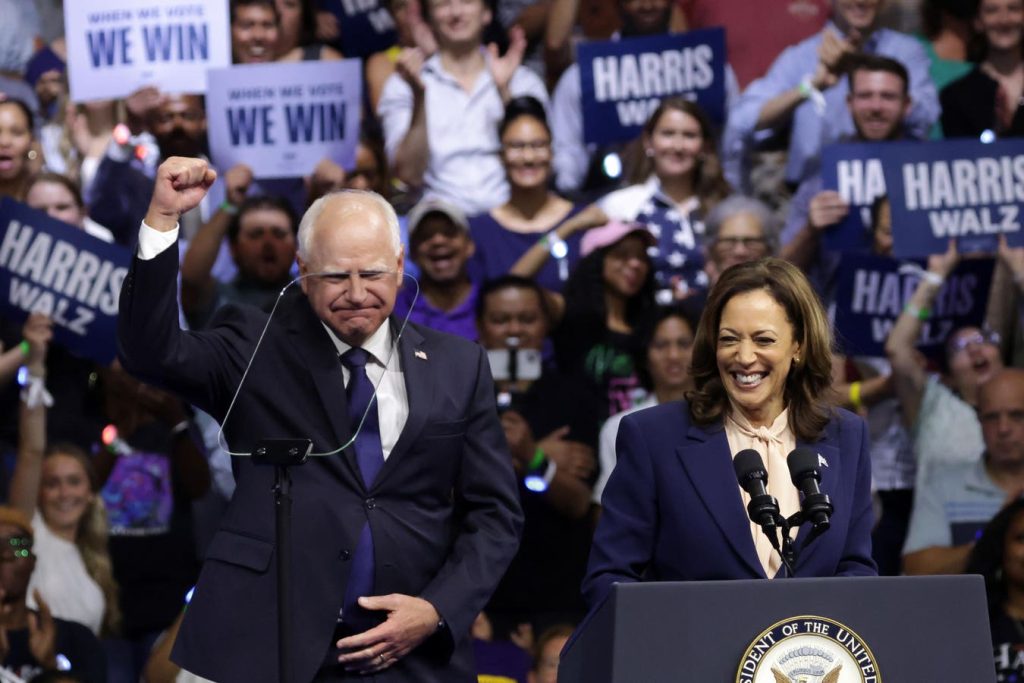Kamala Harris’ choice of Minnesota Governor Tim Walz as her running mate, along with JD Vance’s choice as the Republican vice presidential candidate, shows that economic populism is central for both parties. This is a sharp turn from more market-oriented and internationalist policies that have dominated American economic policy for decades.
The election likely will be won in three older industrial battleground states—Pennsylvania, Michigan, and Wisconsin. Both parties are seeking working class voters in those states, emphasizing economic policies that would have been ruled out by their party leadership just a few years ago.
This so-called “neoliberalism”—an emphasis on free trade, deregulation and market solutions to economic problems, and budget discipline—has lost out to more populist and nationalist economic policies. Although Vance and Walz differ on many issues (climate change, child and family care, diversity, abortion) they both are articulate spokesmen for this populist economic approach.
Consider free trade. It was a cornerstone of Republican policies for decades. And under Bill Clinton, Democrats adopted it as well. Clinton led the fight for NAFTA (the North American Free Trade Agreement) with Canada and Mexico, in spite of significant opposition from unions and Democrats from industrial states.
The larger, and more economically significant free trade policy (also under Clinton), was China’s joining the World Trade Organization (WTO). Clinton believed freer trade was economically beneficial to America, and also that bringing China into world markets would ease international political tensions and encourage democracy there.
But those policies created a backlash. Although many politicians blamed NAFTA for losses in America manufacturing, the rise of China did more economic damage. MIT economist David Autor and his colleagues have analyzed how the “China shock” devasted manufacturing communities in the US, leading to “painful and long-lasting economic scarring and social problems.” Economists Anne Case and Nobel laureate Angus Deaton, in their book Deaths of Despair and the Future of Capitalism, documented how economic decline in these regions led to a spike in drug addiction, alcoholism, and premature deaths.
In response, both parties now endorse more aggressive and nationalist trade policies, especially against China, through tariffs, “Buy American” provisions in procurement, and industrial policies favoring American manufacturing.
Or consider financial deregulation. Republicans traditionally favored banks and financial institutions, but Democrats (again under Clinton) moved to deregulate finance. Clinton pushed for repeal of the Depression-era Glass-Steagall Act, which had separated commercial and investment banking.
When signing the repeal, Clinton’s statement embodied the neoliberal economic consensus: “we are here today to repeal Glass-Steagall because we have learned that government is not the answer…we have learned that we promote economic growth, and we promote stability, by having competition and freedom.”
Neoliberalism also called for budget discipline and financial austerity. Republicans have long called for budget cuts in Social Security and Medicare and adding a Balanced Budget Amendment to the Constitution. Clinton actually balanced the budget (the savings were then spent on regressive tax cuts under George Bush, driving us back into deficit).
And when faced with the Great Recession of 2007, Obama’s policies are now seen as not doing enough deficit spending, even though some of his economic advisers believed much more was required.
Now, these three pillars of neoliberal economics—free trade, financial deregulation, and budget austerity—are largely gone from both Republican and Democratic policies. On trade, Trump instituted tariffs against China and the European Union, and Biden has kept much of those intact. And Trump has called for large, sweeping tariffs if re-elected, even though many economists believe that would cause inflation.
On financial markets and deregulation, in his acceptance speech JD Vance railed against “Wall Street barons.” Both Vance and Democrats now attack big businesses and monopolies. Biden’s Justice Department just won a historic court case where Google was declared a monopoly, while Vance has praised Biden’s Federal Trade Commissioner Lina Khan and her attacks on large firms and concentrated economic power.
Worries about the deficit also have faded. Trump enacted budget-busting tax cuts for the wealthy, and has promised more if elected. Although many Republicans still want to cut Social Security and Medicare, Trump forced the Republican platform committee to say they would protect those benefits.
And although Democrats call for higher taxes on the rich, it isn’t mainly to balance the budget. Instead, they want more revenue for spending on infrastructure, children and families, and programs like Social Security and Medicare.
Harris’ choice of Walz as her running mate shows her desire to engage Trump and Vance, and their working class voters, on these populist economic issues. Conservative writer Sohrab Ahmari says “by picking Tim Walz as her running mate, Harris has gone a long way toward bolstering her left-populist flank and neutralizing Vance’s potential appeal.”
Others are skeptical. Writing before Walz was announced, public opinion scholar Ruy Teixeira says the drift to Trump of working class voters (especially whites) is profound, and hard to change given other forces in the Democratic coalition.
You’ll hear a lot more about which party is better for American workers as the election approaches. Democrats still have an uphill push to reach white working-class voters. But Walz’s selection, and his populist economic themes, shows they want to engage. And it also underscores that both parties have moved a long way from the neoliberal economic policy consensus that has dominated our politics for many years.
Read the full article here




